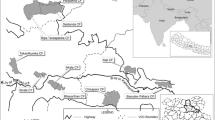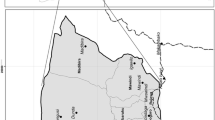Abstract
The development of farm woodlots as an alternative source of livelihood for smallholder farmers in diverse biophysical and socio-economic conditions is a challenging issue in developing countries, such as Rwanda, where the majority of the population relies on subsistence farming. There is a need to understand why and when farmers decide to grow trees and woodlots on their farms. The objective of this study was to analyse the determinants and the purposes that enhance the propensity to grow woodlots in low, medium and high altitude regions of Rwanda. Necessary information for this study came from a survey of 480 households across these regions. The results showed regional variations in the determinants of woodlot farming, demonstrating the importance of not extrapolating the results between regions. Pooled data across regions indicated that age of the householder, number of salaried household members, farm size, travel distance to fuelwood sources and household location in medium forest cover region had positive significant effects on the propensity to grow farm woodlots. In contrast, household location in low forest cover region, ownership of livestock and monthly frequency of purchasing fuelwood were inversely related to the presence of farm woodlots. Many households planted eucalyptus woodlots for economic reasons, not for environmental purposes. Livestock and crop production were more attractive to rural households than woodlot farming. The findings of the study can be used by policymakers and extension services in order to promote sustainable land use practices by focusing on the challenges of competing land uses, farm size, unemployment, dependence on forests for fuelwood supply and subsistence farming.

Similar content being viewed by others
References
Abebe T (2005) Diversity in homegarden agroforestry systems of Southern Ethiopia. Tropical Resource Management. Papers, No. 59. Wageningen University, The Netherlands
Acharya KP (2006) Linking trees on farms with biodiversity conservation in subsistence farming systems in Nepal. Agroforestry and biodiversity conservation: traditional practices, present dynamics, and lessons for the future. Biodivers Conserv 15(2):631–646
Amacher GS, Ersado L, Hyde WF, Osario A (2004) Tree planting in Tigrai, Ethiopia: the importance of human disease and water microdams. Agric Syst 60(3):211–215
Appiah M, Pappinen A (2010) Farm forestry prospects among some local communities in Rachuonyo District, Kenya. Small-scale Forestry 9(3):297–316
Balasubramanian V, Egli A (1986) The role of agroforestry in the farming systems in Rwanda with special reference to the Bugesera–Gisaka–Migongo (BGM) region. Agrofor Syst 4:272–289
Bensel TG, Remedio EM (1995) Residential energy use patterns in Cebu City, Philippines. Energy 20(3):173–187
Bewket W (2003) Household level tree planting and its implications for environmental management in the northwestern highlands of Ethiopia: a case study in the Chemoga Watershed, Blue Nile basin. Land Degrad Dev 14(4):377–388
Brouwer ID, Hoorweg JC, Van Liere MJ (1997) When households run out of fuel: responses of rural households to decreasing fuelwood availability, Ntcheu District, Malawi. World Dev 25(2):255–266
Buyinza M, Wambede N (2008) Extension for agroforestry technology adoption: mixed intercropping of crotalaria (Crotalaria grahamiana) and maize (Zea mays L.) in Kabale District, Uganda. Environ Res J 2(3):131–137
Buyinza MA, Banana AY, Nabanoga G, Ntakimanye A (2008) Socio-economic determinants of farmers’ adoption of rotational woodlot technology in Kigorobya sub-county, Hoina District, Uganda. South Afr J Agric Ext 37:1–16
CGIS-NUR, MINITERE (2008) Cartographie des Forêts du Rwanda 2007. Rapport Final, Vol. 1. Ministry of Lands, Environment, Forestry, Water and Mines, Kigali
Chirwa PW, Ham C, Maphiri S (2008) Baseline study determining consumer behaviour with regard to kitchen management and efficient cooking habits in South Africa. Report prepared for The Programme for Basic Energy and Conservation (ProBEC) by Stellenbosch University
Daneshmandi MS, Azizi M (2009) Allelopathic effect of Eucalyptus globulus Labill. on bermuda grass (Cynodon dactylon (L.) Pers.) germination and rhizome growth. Iran J Med Aromat Plants 25(3):333–346
Delepierre G (1975) Les régions agricoles du Rwanda. Bull Agricole du Rwanda 8(4):216–225
Den Biggelaar DC, Gold MA (1996) Development of utility and location indices for classifying agroforestry species: the case of Rwanda. Agrofor Syst 34(3):229–246
Deressa TT, Hassan RM, Ringler C et al (2009) Determinants of farmers’ choice of adaptation methods to climate change in the Nile Basin of Ethiopia. Global Environ Change 19(2):248–255
Dev I, Misri B, Pathania MS (2006) Forage demand and supply in western Himalaya: a balance sheet for Himachal Pradesh. Indian J Anim Sci 76(9):720–726
Dewees PA (1995) Trees on farms in Malawi: private investment, public policy, and farmer choice. World Dev 23(7):1085–1102
Dewees PA, Saxena NC (1997) Wood product markets as incentives for farmer tree growing. In: Arnold JEM, Dewees P (eds) Farms, trees and farmers: responses to agricultural intensification. Earthscan, London
Dixit G, Dixit SV (2010) Conservation of natural resources and socio economic upliftment through agroforestry practices in sub Himalayan Terai region of Uttar Pradesh. Int J For Usufructs Manag 11(1):33–36
Duguma LA, Hager H (2010) Woody plant diversity and possession, and their future prospects in small-scale tree and shrub growing in agricultural landscapes in central highlands of Ethiopia. Small-scale Forestry 9(2):153–174
El-Rokiek KG, Eid RA (2009) Allelopathic effects of Eucalyptus citriodora on amaryllis and associated grassy weed. Planta Daninha 27:887–899
Emtage N, Suh J (2004) Socio-economic factors affecting smallholder tree planting and management intensions in Leyte province, the Philippines. Small Scale For Econ Manag Policy 3(2):257–271
Erickson D, De Young R (1993) Management of farm woodlots and windbreaks: some psychological and landscape patterns. J Environ Syst 22(3):233–247
Erickson DL, Ryan RL, De Young R (2002) Woodlots in the rural landscape: landowner motivations and management attitudes in a Michigan (USA) case study. Landsc Urban Plan 58:101–112
Garrity DP, Stapleton P (2011) More trees on farms. Farm Matters 27(2):8–9
Gebreegziabher Z, Mekonnen A, Kassie M, Kohlin G (2010a) Household tree planting in Tigrai, Nothern Ethiopia: tree species, purposes, and determinants. Environmental for Development, Discussion Paper Series 10-01
Gebreegziabher Z, Oskam AJ, Bayou D (2010b) Urban fuel demand in Ethiopia: An almost-ideal demand system approach. Environmental for Development, Discussion Paper Series 10-15
Hansen JD, Luckert MK, Minae S, Place F (2005) Tree planting under customary tenure systems in Malawi: impact of marriage and inheritance patterns. Agric Syst 84(1):99–118
Hyde WF, Kohlin G, Amacher GS (2000) Social forestry reconsidered. In: Hyde WF, Amacher GS (eds) Economics of forestry and rural development: an empirical introduction from Asia. University of Michigan Press, Ann Arbor
Jenbere D, Lemenith M, Kassa H (2012) Expansion of eucalyptus farm forestry and its determinants in Arsi Negelle District, South Central Ethiopia. Small-scale For 11:389–405
Johnson VE, Albert JH (1999) Ordinal data modeling. Springer, New York
Kabwe G, Bigsby H, Cullen R (2009) Factors influencing adoption of agroforestry among smallholder farmers in Zambia. Paper presented at the 2009 NZARES conference, Tahuna Conference Centre, Nelson, 27–28 Aug 2009
Kibria MG, Saha N (2011) Analysis of existing agroforestry practices in Madhupur Sal forest: an assessment based on ecological and economic perspectives. J For Res 22(4):533–542
Kimaro AA, Timmer VR, Mugasha AG et al (2007) Nutrient use efficiency and biomass production of tree species for rotational woodlot systems in semi-arid Morogoro, Tanzania. Agrofor Syst 71:175–184
Lovell ST, Mendez VE, DeSantis S, Erickson DL, Nathan C (2010) Extent, pattern, and multifunctionality of treed habitats on farms in Vermont, USA. Agrofor Syst 80(2):153–171
Mallik RM (2006) Household consumption pattern of fuel energy and emerging crisis: an analytical investigation in a regional perspective. Indian Forester 132(11):1398–1418
Mekonnen A (1998) Rural energy and afforestation: case studies from Ethiopia. PhD, Department of Economics, Gothenberg University
Mekonnen Z, Kassa H, Lemenih M, Campbell B (2007) The role and management of eucalyptus in Lode Hetosa district, Central Ethiopia. For Trees and Livelihoods 17(4):309–323
Mugabo JR (2003) Farm-level incentives for fertilizer use in Rwanda’s Kigali Rural Province: a financial analysis. MSc. Thesis. Michigan State University
Ndayambaje JD, Mohren GMJ (2011) Fuelwood demand and supply in Rwanda and the role of agroforestry. Agrofor Syst 83(3):303–320. doi:10.1007/s10457-011-9391-6
Ndayambaje JD, Heijman WJM, Mohren GMJ (2012) Household determinants of tree planting on farms in rural Rwanda. Small-scale Forestry 11(4):477–508
Neupane RP, Sharma KR, Thapa GB (2002) Adoption of agroforestry in the hills of Nepal: a logistic regression analysis. Agric Syst 72:177–196
Nibbering JW (1999) Tree planting on deforested farmlands, Sewu Hills, Java, Indonesia: impact of economic and institutional changes. Agric Syst 46(1):65–82
NISR (2010) National agricultural survey 2008. Results of final data analysis. National Institute of Statistics of Rwanda, Kigali. http://www.statistics.gov.rw/images/PDF/agricole2008.pdf. Accessed 2 Aug 2010
Ntakimanyire A, Buyinza M (2008) Rotational woodlot technology in Kigorobya sub-county, Hoima District, Uganda. Bot Res J 1:36–42
Nyadzi GI, Janssen BH, Oenema O (2006) Analysis of the effects of rotational woodlots on the nutrition and yield of maize following trees in western Tanzania. Agric Ecosyst Environ 116(1–2):93–103
Nyazi GI, Otsyina RM, Banzi FM et al (2003) Rotational woodlot technology in northwestern Tanzania: tree species and crop performance. Agrofor Syst 59:253–263
Patel SH, Pinckney TC, Jaeger WK (1995) Smallholder wood production and population pressure in East Africa: evidence of an environmental Kuznets curve? Land Econ 71:500–515
Pattanayak S, Mercer DE, Sills E, Yang J (2003) Taking stock of agroforestry adoption studies. Agrofor Syst 57:173–186
Predo CD, Francisco HA (2006) Understanding tree-growing decisions of smallholder farmers in Claveria, Northern Mindanao, The Philippines. Philipp J Crop Sci 31(3):3–20
Salam MA, Noguchi T, Koike M (2000) Understanding why farmers plant trees in the homestead agroforestry in Bangladesh. Agrofor Syst 50(1):77–93
Sinclair FL (1999) A general classification of agroforestry practice. Agrofor Syst 46:161–180
Smith HL (1989) Integrating theory and research on the institutional determinants of fertility. Demography 26(2):171–184
Stewart HTL, Race DH, Curtis AL, Stewart AJK (2011) A case study of socio-economic returns from farm forestry and agriculture in south-east Australia during 1993–2007. For Policy Econ 13(5):390–395
Teshome M (2004) Economics of growing Eucalyptus globulus on farmers’ woodlot; the case of Kutaber District, South Wollo. MSc Thesis, Wondo Genet College of Forestry, Debub University
Tolera M, Asfaw Z, Lemenih M, Karltun E (2008) Woody species diversity in a changing landscape in the south-central highlands of Ethiopia. Agric Ecosyst Environ 128(1):52–58
WFP (2006) Comprehensive Food Security and Vulnerability Assessment. Strengthening Emergency Needs Assessment Capacity (SENAC) Project. World Food Programme of the United Nations, Kigali
Wiersum KF, Elands BHM, Hoogstra MA (2005) Small-scale forest ownership across Europe: characteristics and future potential. Small-scale For Econ Manag Policy 4(1):1–19
Acknowledgments
This study is part of the PhD Programme of the first author at Wageningen University, the Netherlands, funded by Netherlands Organization for international cooperation in higher education (NUFFIC, grant nr. CF2906/2006 under the agreement between Rwanda Agricultural Research Institute (ISAR) and NUFFIC). We are grateful to ISAR for facilitation during this study. We thanks Jean Claude Bambe, Barnabé Bizeye, Thomas Gakwavu, Théoneste Hakizimana, Gilbert Ndizeye, Roger T. Mahamuri, Eustache Nkikabahizi, Epaphrodite Gakwerere Nkuba, Fréderic Ntakirutimana, Claudine Nyiraneza, Fiston Rugira, Innocent Ufitumurame, Providence Uwayezu and Marcellin Uwimpuhwe for their assistance in data collection, coding of interview responses and data entry. We are also grateful to the farmers who participated in the survey.
Author information
Authors and Affiliations
Corresponding author
Rights and permissions
About this article
Cite this article
Ndayambaje, J.D., Heijman, W.J.M. & Mohren, G.M.J. Farm woodlots in rural Rwanda: purposes and determinants. Agroforest Syst 87, 797–814 (2013). https://doi.org/10.1007/s10457-013-9597-x
Received:
Accepted:
Published:
Issue Date:
DOI: https://doi.org/10.1007/s10457-013-9597-x




